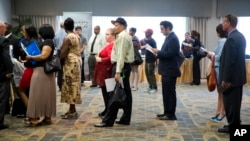A number of economists predict that unemployment will drop to around its lowest practical level in the United States by the end of 2016. But others say employers remain cautious about taking on new workers, and wages are growing at a frustratingly slow pace.
The U.S. unemployment rate was 5 percent in November, a dramatic drop from the 10 percent jobless rate seen at the worst of the recession in late 2009. Government experts also say the number of Americans seeking unemployment benefits is hovering close to its lowest level in four decades.
Jobless rate down
Top officials of the U.S. central bank project that the unemployment rate will fall further, to about 4.7 percent by the end of 2016. Other experts offer projections similar to those from the Federal Reserve.
Peter Cardillo, Chief Market Economist at First Standard Financial, expects economic growth to "cool" a bit over the next six months, but says the job market will continue to grow, pushing the jobless rate down to 4.6 or 4.7 percent.
Experts at PNC bank predict "solid job gains" that will push unemployment down to 4.6 percent.
Full employment?
Many economists say the rate can't go much lower than that because a certain percentage of people are in the midst of changing jobs, finishing school or switching from one seasonal job to another. That is why they call a jobless rate around 4.6 percent "full employment," even though not all U.S. adults are working.
The academic definition of "full employment" may be viewed skeptically by the 7.9 million people who are currently out of work, including more than two million who have been jobless for six months or more.
The Bureau of Labor Statistics also says just over 6 million people are working part-time because they cannot find full-time employment, and another 600,000 have simply given up their search.
This underemployment is one reason Federal Reserve Chair Janet Yellen and her colleagues waited before raising the key interest rate earlier this month, and why they say future increases will depend on economic data and will be gradual.
Slow wage growth
While the U.S. economy has been growing at a modest rate since the recession, many workers are frustrated that wages have not increased more rapidly.
Presidential economic adviser Jason Furman says wage growth was 2.3 percent during the past year, but said there is still "work to do" to speed up growth in wages and jobs.
Analysts at Beyond.com say companies need to hire new workers, and they are vetting candidates.
But Senior Vice President Joe Weinlick says companies are worried that economic growth could falter, and they are being very selective and slow about bringing on new employees.












